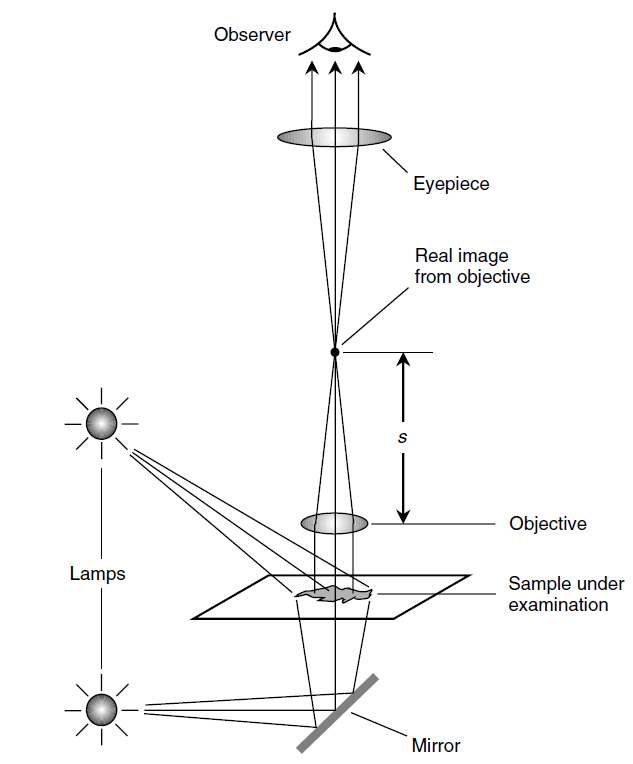


 الفيزياء الكلاسيكية
الفيزياء الكلاسيكية
 الكهربائية والمغناطيسية
الكهربائية والمغناطيسية
 علم البصريات
علم البصريات
 الفيزياء الحديثة
الفيزياء الحديثة
 النظرية النسبية
النظرية النسبية
 الفيزياء النووية
الفيزياء النووية
 فيزياء الحالة الصلبة
فيزياء الحالة الصلبة
 الليزر
الليزر
 علم الفلك
علم الفلك
 المجموعة الشمسية
المجموعة الشمسية
 الطاقة البديلة
الطاقة البديلة
 الفيزياء والعلوم الأخرى
الفيزياء والعلوم الأخرى
 مواضيع عامة في الفيزياء
مواضيع عامة في الفيزياء|
Read More
Date: 23-3-2016
Date: 23-1-2021
Date: 20-3-2016
|
BASIC PRINCIPLE
A compound microscope employs two lenses. The objective has a short focal length, in some cases 1 mm or less, and is placed near the specimen or sample to be observed. This produces an image at some distance above the objective, where the light rays come to a focus. The distance (let’s call it s) between the objective and this image is always greater than the focal length of the objective.
The eyepiece has a longer focal length than the objective. It magnifies the real image produced by the objective. In a typical microscope, illumination can be provided by shining a light upward through the sample if the sample is translucent. Some microscopes allow for light to be shone downward on opaque specimens. Figure 1 is a simplified diagram of a compound microscope showing how the light rays are focused and how the specimen can be illuminated.
Laboratory-grade compound microscopes have two or more objectives, which can be selected by rotating a wheel to which each objective is attached. This provides several different levels of magnification for a given eyepiece. In general, as the focal length of the objective becomes shorter, the magnification of the microscope increases. Some compound microscopes can magnify images up to about 2,500 times. A hobby-grade compound microscope can provide decent image quality at magnifications of up to about 1,000 times.

Fig. 1. Illumination and focusing in a compound optical microscope.



|
|
|
|
دخلت غرفة فنسيت ماذا تريد من داخلها.. خبير يفسر الحالة
|
|
|
|
|
|
|
ثورة طبية.. ابتكار أصغر جهاز لتنظيم ضربات القلب في العالم
|
|
|
|
|
|
|
قسم شؤون المعارف ووفد من جامعة البصرة يبحثان سبل تعزيز التعاون المشترك
|
|
|